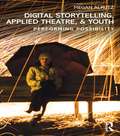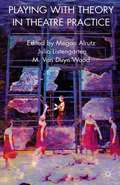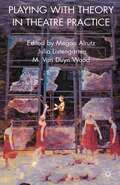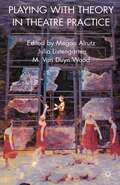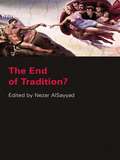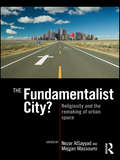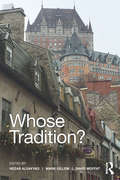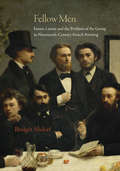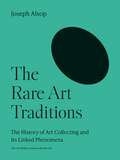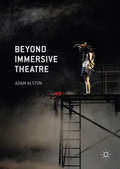- Table View
- List View
The Art of Coding: The Language of Drawing, Graphics, and Animation
by Mohammad Majid al-Rifaie Anna Ursyn Theodor WyeldAs the title suggests, this book explores the concepts of drawing, graphics and animation in the context of coding. In this endeavour, in addition to initiating the process with some historical perspectives on programming languages, it prides itself by presenting complex concepts in an easy-to-understand fashion for students, artists, hobbyists as well as those interested in computer science, computer graphics, digital media, or interdisciplinary studies. Being able to code requires abstract thinking, mathematics skills, spatial ability, logical thinking, imagination, and creativity. All these abilities can be acquired with practice, and can be mastered by practical exposure to art, music, and literature. This book discusses art, poetry and other forms of writing while pondering difficult concepts in programming; it looks at how we use our senses in the process of learning computing and programming. Features: Introduces coding in a visual way Explores the elegance behind coding and the outcome Includes types of outcomes and options for coding Covers the transition from front-of-classroom instruction to the use of online-streamed video tutorials Encourages abstract and cognitive thinking, as well as creativity The Art of Coding contains a collection of learning projects for students, instructors and teachers to select specific themes from. Problems and projects are aimed at making the learning process entertaining, while also involving social exchange and sharing. This process allows for programming to become interdisciplinary, enabling projects to be co-developed by specialists from different backgrounds, enriching the value of coding and what it can achieve. The authors of this book hail from three different continents, and have several decades of combined experience in academia, education, science and visual arts. Source Code: The source code for the book can be accessed here.
Digital Storytelling, Applied Theatre, & Youth: Performing Possibility
by Megan AlrutzDigital Storytelling, Applied Theatre, & Youth argues that theatre artists must re-imagine how and why they facilitate performance practices with young people. Rapid globalization and advances in media and technology continue to change the ways that people engage with and understand the world around them. Drawing on pedagogical, aesthetic, and theoretical threads of applied theatre and media practices, this book presents practitioners, scholars, and educators with innovative approaches to devising and performing digital stories. This book offers the first comprehensive examination of digital storytelling as an applied theatre practice. Alrutz explores how participatory and mediated performance practices can engage the wisdom and experience of youth; build knowledge about self, others and society; and invite dialogue and deliberation with audiences. In doing so, she theorizes digital storytelling as a site of possibility for critical and relational practices, feminist performance pedagogies, and alliance building with young people.
Digital Storytelling, Applied Theatre, & Youth: Performing Possibility
by Megan AlrutzDigital Storytelling, Applied Theatre, & Youth argues that theatre artists must re-imagine how and why they facilitate performance practices with young people. Rapid globalization and advances in media and technology continue to change the ways that people engage with and understand the world around them. Drawing on pedagogical, aesthetic, and theoretical threads of applied theatre and media practices, this book presents practitioners, scholars, and educators with innovative approaches to devising and performing digital stories. This book offers the first comprehensive examination of digital storytelling as an applied theatre practice. Alrutz explores how participatory and mediated performance practices can engage the wisdom and experience of youth; build knowledge about self, others and society; and invite dialogue and deliberation with audiences. In doing so, she theorizes digital storytelling as a site of possibility for critical and relational practices, feminist performance pedagogies, and alliance building with young people.
Devising Critically Engaged Theatre with Youth: The Performing Justice Project
by Megan Alrutz Lynn HoareDevising Critically Engaged Theatre with Youth: The Performing Justice Project offers accessible frameworks for devising original theatre, developing critical understandings of racial and gender justice, and supporting youth to imagine, create, and perform possibilities for a more just and equitable society. Working at the intersections of theory and practice, Alrutz and Hoare present their innovative model for devising critically engaged theatre with novice performers. Sharing why and how the Performing Justice Project (PJP) opens dialogue around challenging and necessary topics already facing young people, the authors bring together critical information about racial and gender justice with new and revised practices from applied theatre, storytelling, theatre, and education for social change. Their curated collection of PJP "performance actions" offers embodied and reflective approaches for building ensemble, devising and performing stories, and exploring and analyzing individual and systemic oppression. This work begins to confront oppressive narratives and disrupt patriarchal systems—including white supremacy, racism, sexism, and homophobia. Devising Critically Engaged Theatre with Youth invites artists, teaching artists, educators, and youth-workers to collaborate bravely with young people to imagine and enact racial and gender justice in their lives and communities. Drawing on examples from PJP residencies in juvenile justice settings, high schools, foster care facilities, and community-based organizations, this book offers flexible and responsive ways for considering experiences of racism and sexism and performing visions of justice. Visit performingjusticeproject.org for additional information and documentation of PJP performances with youth.
Devising Critically Engaged Theatre with Youth: The Performing Justice Project
by Megan Alrutz Lynn HoareDevising Critically Engaged Theatre with Youth: The Performing Justice Project offers accessible frameworks for devising original theatre, developing critical understandings of racial and gender justice, and supporting youth to imagine, create, and perform possibilities for a more just and equitable society. Working at the intersections of theory and practice, Alrutz and Hoare present their innovative model for devising critically engaged theatre with novice performers. Sharing why and how the Performing Justice Project (PJP) opens dialogue around challenging and necessary topics already facing young people, the authors bring together critical information about racial and gender justice with new and revised practices from applied theatre, storytelling, theatre, and education for social change. Their curated collection of PJP "performance actions" offers embodied and reflective approaches for building ensemble, devising and performing stories, and exploring and analyzing individual and systemic oppression. This work begins to confront oppressive narratives and disrupt patriarchal systems—including white supremacy, racism, sexism, and homophobia. Devising Critically Engaged Theatre with Youth invites artists, teaching artists, educators, and youth-workers to collaborate bravely with young people to imagine and enact racial and gender justice in their lives and communities. Drawing on examples from PJP residencies in juvenile justice settings, high schools, foster care facilities, and community-based organizations, this book offers flexible and responsive ways for considering experiences of racism and sexism and performing visions of justice. Visit performingjusticeproject.org for additional information and documentation of PJP performances with youth.
Playing With Theory In Theatre Practice (PDF)
by Megan Alrutz Julia Listengarten M. WoodThrough a collection of original essays and case studies, this innovative book explores theory as an accessible, although complex, tool for theatre practitioners and students. These chapters invite readers to (re)imagine theory as a site of possibility or framework that can shape theatre making, emerge from practice, and foster new ways of seeing, creating, and reflecting. Focusing on the productive tensions and issues that surround creative practice and intellectual processes, the contributing authors present central concepts and questions that frame the role of theory in the theatre. Ultimately, this diverse and exciting collection offers inspiring ideas, raises new questions, and introduces ways to build theoretically-minded, dynamic production work.
Playing with Theory in Theatre Practice
by Megan Alrutz Julia Listengarten M. Van WoodThrough a collection of original essays and case studies, this innovative book explores theory as an accessible, although complex, tool for theatre practitioners and students. These chapters invite readers to (re)imagine theory as a site of possibility or framework that can shape theatre making, emerge from practice, and foster new ways of seeing, creating, and reflecting. Focusing on the productive tensions and issues that surround creative practice and intellectual processes, the contributing authors present central concepts and questions that frame the role of theory in the theatre. Ultimately, this diverse and exciting collection offers inspiring ideas, raises new questions, and introduces ways to build theoretically-minded, dynamic production work.
Playing with Theory in Theatre Practice
by Megan Alrutz Julia Listengarten M. Van WoodThrough a collection of original essays and case studies, this innovative book explores theory as an accessible, although complex, tool for theatre practitioners and students. These chapters invite readers to (re)imagine theory as a site of possibility or framework that can shape theatre making, emerge from practice, and foster new ways of seeing, creating, and reflecting. Focusing on the productive tensions and issues that surround creative practice and intellectual processes, the contributing authors present central concepts and questions that frame the role of theory in the theatre. Ultimately, this diverse and exciting collection offers inspiring ideas, raises new questions, and introduces ways to build theoretically-minded, dynamic production work.
Consuming Tradition, Manufacturing Heritage: Global Norms and Urban Forms in the Age of Tourism
by Nezar AlsayyadFrom the Grand Tour to today's packages holidays, the last two centuries have witnessed an exponential growth in travel and tourism and, as the twenty-first century unfolds, people of every class and from every country will be wandering to every part of the planet.Meanwhile tourist destinations throughout the world find themselves in ever more fierce competition - those places marginalized in today's global industrial and information economy perceiving tourism as perhaps the only means of surviving. But mass tourism has raised the local and international passions as people decry the irreversible destruction of traditional places and historic sites.Against these trends and at a time when standardized products and services are marketed worldwide, there is an increasing demand for built environments that promise unique cultural experiences. This has led many nations and groups to engage in the parallel processes of facilitating the consumption of tradition and of manufacturing tradition.The contributors to this volume - drawn from a wide range of disciplines - address these themes within the following sections: Traditions and Tourism: Rethinking the "Other"; Imaging and Manufacturing Heritage; Manufacturing and Consuming: Global and Local. Their studies, dealing with very different times, environments and geographic locales, will shed new light on how tourist 'gaze' transforms the reality of built spaces into cultural imagery.
Consuming Tradition, Manufacturing Heritage: Global Norms and Urban Forms in the Age of Tourism
by Nezar AlSayyadFrom the Grand Tour to today's packages holidays, the last two centuries have witnessed an exponential growth in travel and tourism and, as the twenty-first century unfolds, people of every class and from every country will be wandering to every part of the planet.Meanwhile tourist destinations throughout the world find themselves in ever more fierce competition - those places marginalized in today's global industrial and information economy perceiving tourism as perhaps the only means of surviving. But mass tourism has raised the local and international passions as people decry the irreversible destruction of traditional places and historic sites.Against these trends and at a time when standardized products and services are marketed worldwide, there is an increasing demand for built environments that promise unique cultural experiences. This has led many nations and groups to engage in the parallel processes of facilitating the consumption of tradition and of manufacturing tradition.The contributors to this volume - drawn from a wide range of disciplines - address these themes within the following sections: Traditions and Tourism: Rethinking the "Other"; Imaging and Manufacturing Heritage; Manufacturing and Consuming: Global and Local. Their studies, dealing with very different times, environments and geographic locales, will shed new light on how tourist 'gaze' transforms the reality of built spaces into cultural imagery.
The End of Tradition?
by Nezar AlsayyadRooted in real world observations, this book questions the concept of tradition - whether contemporary globalization will prove its demise or whether there is a process of simultaneous ending and renewing. In his introduction, Nezar Alsayyad discusses the meaning of the word 'tradition' and the current debates about the 'end of tradition'. Thereafter the book is divided into three parts. The three chapters in part I explore the inextricable link between 'tradition' and 'modern', revealing the geopolitical implications of this link. Part II looks at tradition as a process of invention and here the three chapters are all concerned with the making of landscapes and landscape myths, showing how the spectacle of history can be aestheticized and naturalized. Finally, Part III shows how traditionis a regime, programmed and policed and how it has been deployed, resisted, and reworked through hegemonic struggles that seek to create both built environments and citizen-subjects.
The End of Tradition?
by Nezar AlSayyadRooted in real world observations, this book questions the concept of tradition - whether contemporary globalization will prove its demise or whether there is a process of simultaneous ending and renewing. In his introduction, Nezar Alsayyad discusses the meaning of the word 'tradition' and the current debates about the 'end of tradition'. Thereafter the book is divided into three parts. The three chapters in part I explore the inextricable link between 'tradition' and 'modern', revealing the geopolitical implications of this link. Part II looks at tradition as a process of invention and here the three chapters are all concerned with the making of landscapes and landscape myths, showing how the spectacle of history can be aestheticized and naturalized. Finally, Part III shows how traditionis a regime, programmed and policed and how it has been deployed, resisted, and reworked through hegemonic struggles that seek to create both built environments and citizen-subjects.
The Fundamentalist City?: Religiosity and the Remaking of Urban Space
by Nezar AlSayyadThe relationship between urbanism and fundamentalism is a very complex one. This book explores how the dynamics of different forms of religious fundamentalisms are produced, represented, and practiced in the city. It attempts to establish a relationship between two important phenomena: the historic transition of the majority of the world’s population from a rural to an urban existence; and the robust resurgence of religion as a major force in the shaping of contemporary life in many parts of the world. Employing a transnational interrogation anchored in specific geographic regions, the contributors to this volume explore the intellectual and practical challenges posed by fundamentalist groups, movements, and organizations. They focus on how certain ultra religious practices of Christianity, Hinduism, Islam, and Judaism have contributed to the remaking of global urban space. Their work suggests that it is a grave oversimplification to view religious orthodoxies or doctrines as the main cause of urban terrorism or violence. Instead they argue that such phenomena should be understood as a particular manifestation of modernity’s struggles. Nezar AlSayyad and Mejgan Massoumi’s book provides fascinating reading for those interested in religion and the city, with thought provoking pieces from experts in anthropology, geography sociology, religious studies, and urban studies.
Routledge Handbook on Cairo: Histories, Representations and Discourses
by Nezar AlSayyadThis Handbook simultaneously provides a single text that narrates the Cairo of yesterday and of today, and gives the reader a major reference to the best of Cairo scholarship. Divided into three parts covering Histories, Representations and Discourses of Cairo, the chapters provide comprehensive coverage of Cairo from both a disciplinary and an interdisciplinary point of view, with scholars from a great range of disciplines. Part One contains chapters on the history of specific parts of the city to provide both a concise picture of Cairo and an appreciation for the diversity of its constituent parts and periods. Part Two of the book deals with the various forms of representations of the city, from high-end literature to popular songs, and from photographs to films. Finally, Part Three covers current discourses about the city, comprising historical reflections on the city from the present, surveys of its current condition, analysis of it serious urban problems and visions for its future. The Routledge Handbook on Cairo provides a unique and innovative look at the ever-evolving state of Cairo. It will be a vital reference source for scholars and students of Middle Eastern Studies, Middle East History, Cultural Studies, Urban Studies, Architecture and Politics.
Routledge Handbook on Cairo: Histories, Representations and Discourses
by Nezar AlSayyadThis Handbook simultaneously provides a single text that narrates the Cairo of yesterday and of today, and gives the reader a major reference to the best of Cairo scholarship. Divided into three parts covering Histories, Representations and Discourses of Cairo, the chapters provide comprehensive coverage of Cairo from both a disciplinary and an interdisciplinary point of view, with scholars from a great range of disciplines. Part One contains chapters on the history of specific parts of the city to provide both a concise picture of Cairo and an appreciation for the diversity of its constituent parts and periods. Part Two of the book deals with the various forms of representations of the city, from high-end literature to popular songs, and from photographs to films. Finally, Part Three covers current discourses about the city, comprising historical reflections on the city from the present, surveys of its current condition, analysis of it serious urban problems and visions for its future. The Routledge Handbook on Cairo provides a unique and innovative look at the ever-evolving state of Cairo. It will be a vital reference source for scholars and students of Middle Eastern Studies, Middle East History, Cultural Studies, Urban Studies, Architecture and Politics.
Whose Tradition?: Discourses on the Built Environment
by Nezar AlSayyad Mark Gillem David MoffatIn seeking to answer the question Whose Tradition? this book pursues four themes: Place: Whose Nation, Whose City?; People: Whose Indigeneity?; Colonialism: Whose Architecture?; and Time: Whose Identity?Following Nezar AlSayyad’s Prologue, contributors addressing the first theme take examples from Indonesia, Myanmar and Brazil to explore how traditions rooted in a particular place can be claimed by various groups whose purposes may be at odds with one another. With examples from Hong Kong, a Santal village in eastern India and the city of Kuala Lumpur, contributors investigate the concept of indigeneity, the second theme, and its changing meaning in an increasingly globalized milieu from colonial to post-colonial times. Contributors to the third theme examine the lingering effects of colonial rule in altering present-day narratives of architectural identity, taking examples from Guam, Brazil, and Portugal and its former colony, Mozambique. Addressing the final theme, contributors take examples from Africa and the United States to demonstrate how traditions construct identities, and in turn how identities inform the interpretation and manipulation of tradition within contexts of socio-cultural transformation in which such identities are in flux and even threatened. The book ends with two reflective pieces: the first drawing a comparison between a sense of ‘home’ and a sense of tradition; the second emphasizing how the very concept of a tradition is an attempt to pin down something that is inherently in flux.
The Fundamentalist City?: Religiosity and the Remaking of Urban Space
by Nezar AlSayyad Mejgan MassoumiThe relationship between urbanism and fundamentalism is a very complex one. This book explores how the dynamics of different forms of religious fundamentalisms are produced, represented, and practiced in the city. It attempts to establish a relationship between two important phenomena: the historic transition of the majority of the world’s population from a rural to an urban existence; and the robust resurgence of religion as a major force in the shaping of contemporary life in many parts of the world. Employing a transnational interrogation anchored in specific geographic regions, the contributors to this volume explore the intellectual and practical challenges posed by fundamentalist groups, movements, and organizations. They focus on how certain ultra religious practices of Christianity, Hinduism, Islam, and Judaism have contributed to the remaking of global urban space. Their work suggests that it is a grave oversimplification to view religious orthodoxies or doctrines as the main cause of urban terrorism or violence. Instead they argue that such phenomena should be understood as a particular manifestation of modernity’s struggles. Nezar AlSayyad and Mejgan Massoumi’s book provides fascinating reading for those interested in religion and the city, with thought provoking pieces from experts in anthropology, geography sociology, religious studies, and urban studies.
Fellow Men: Fantin-Latour and the Problem of the Group in Nineteenth-Century French Painting
by Bridget AlsdorfFocusing on the art of Henri Fantin-Latour (1836-1904) and his colleagues Gustave Courbet, Edgar Degas, Edouard Manet, Frédéric Bazille, and Pierre-Auguste Renoir, Fellow Men argues for the importance of the group as a defining subject of nineteenth-century French painting. Through close readings of some of the most ambitious paintings of the realist and impressionist generation, Bridget Alsdorf offers new insights into how French painters understood the shifting boundaries of their social world, and reveals the fragile masculine bonds that made up the avant-garde.A dedicated realist who veered between extremes of sociability and hermetic isolation, Fantin-Latour painted group dynamics over the course of two decades, from 1864 to 1885. This was a period of dramatic change in French history and art--events like the Paris Commune and the rise and fall of impressionism raised serious doubts about the power of collectivism in art and life. Fantin-Latour's monumental group portraits, and related works by his friends and colleagues from the 1850s through the 1880s, represent varied visions of collective identity and test the limits of association as both a social and an artistic pursuit. By examining the bonds and frictions that animated their social circles, Fantin-Latour and his cohorts developed a new pictorial language for the modern group: one of fragmentation, exclusion, and willful withdrawal into interior space that nonetheless presented individuality as radically relational.
Fellow Men: Fantin-Latour and the Problem of the Group in Nineteenth-Century French Painting
by Bridget AlsdorfFocusing on the art of Henri Fantin-Latour (1836-1904) and his colleagues Gustave Courbet, Edgar Degas, Edouard Manet, Frédéric Bazille, and Pierre-Auguste Renoir, Fellow Men argues for the importance of the group as a defining subject of nineteenth-century French painting. Through close readings of some of the most ambitious paintings of the realist and impressionist generation, Bridget Alsdorf offers new insights into how French painters understood the shifting boundaries of their social world, and reveals the fragile masculine bonds that made up the avant-garde.A dedicated realist who veered between extremes of sociability and hermetic isolation, Fantin-Latour painted group dynamics over the course of two decades, from 1864 to 1885. This was a period of dramatic change in French history and art--events like the Paris Commune and the rise and fall of impressionism raised serious doubts about the power of collectivism in art and life. Fantin-Latour's monumental group portraits, and related works by his friends and colleagues from the 1850s through the 1880s, represent varied visions of collective identity and test the limits of association as both a social and an artistic pursuit. By examining the bonds and frictions that animated their social circles, Fantin-Latour and his cohorts developed a new pictorial language for the modern group: one of fragmentation, exclusion, and willful withdrawal into interior space that nonetheless presented individuality as radically relational.
Gawkers: Art and Audience in Late Nineteenth-Century France
by Bridget AlsdorfHow the urban spectator became the archetypal modern viewer and a central subject in late nineteenth-century French artGawkers explores how artists and writers in late nineteenth-century Paris represented the seductions, horrors, and banalities of street life through the eyes of curious viewers known as badauds. In contrast to the singular and aloof bourgeois flâneur, badauds were passive, collective, instinctive, and highly impressionable. Above all, they were visual, captivated by the sights of everyday life. Beautifully illustrated and drawing on a wealth of new research, Gawkers excavates badauds as a subject of deep significance in late nineteenth-century French culture, as a motif in works of art, and as a conflicted model of the modern viewer.Bridget Alsdorf examines the work of painters, printmakers, and filmmakers who made badauds their artistic subject, including Félix Vallotton, Pierre Bonnard, Henri de Toulouse-Lautrec, Honoré Daumier, Edgar Degas, Jean-Léon Gérôme, Eugène Carrière, Charles Angrand, and Auguste and Louise Lumière. From morally and intellectually empty to sensitive, empathetic, and humane, the gawkers these artists portrayed cut across social categories. They invite the viewer’s identification, even as they appear to threaten social responsibility and the integrity of art.Delving into the ubiquity of a figure that has largely eluded attention, idling on the margins of culture and current events, Gawkers traces the emergence of social and aesthetic problems that are still with us today.
Gawkers: Art and Audience in Late Nineteenth-Century France
by Bridget AlsdorfHow the urban spectator became the archetypal modern viewer and a central subject in late nineteenth-century French artGawkers explores how artists and writers in late nineteenth-century Paris represented the seductions, horrors, and banalities of street life through the eyes of curious viewers known as badauds. In contrast to the singular and aloof bourgeois flâneur, badauds were passive, collective, instinctive, and highly impressionable. Above all, they were visual, captivated by the sights of everyday life. Beautifully illustrated and drawing on a wealth of new research, Gawkers excavates badauds as a subject of deep significance in late nineteenth-century French culture, as a motif in works of art, and as a conflicted model of the modern viewer.Bridget Alsdorf examines the work of painters, printmakers, and filmmakers who made badauds their artistic subject, including Félix Vallotton, Pierre Bonnard, Henri de Toulouse-Lautrec, Honoré Daumier, Edgar Degas, Jean-Léon Gérôme, Eugène Carrière, Charles Angrand, and Auguste and Louise Lumière. From morally and intellectually empty to sensitive, empathetic, and humane, the gawkers these artists portrayed cut across social categories. They invite the viewer’s identification, even as they appear to threaten social responsibility and the integrity of art.Delving into the ubiquity of a figure that has largely eluded attention, idling on the margins of culture and current events, Gawkers traces the emergence of social and aesthetic problems that are still with us today.
Rethinking IT in Construction and Engineering: Organisational Readiness
by Mustafa AlshawiHow could the potential of IT be realised to improve business performance in architecture, construction and engineering organisations? How could organisations unleash the potential of IT to achieve a sustainable competitive advantage? How can organisations migrate from technology to IT-enabled business thinking? Based on the author's twenty years research experience, this book provides a holistic picture of the factors that enable architecture, construction and engineering organisations to explore the potential of IT to improve their businesses and achieve a sustainable competitive advantage. It raises awareness of the importance of the organisational 'soft issues' and the role they play in influencing the outcome of IT investments as well as addressing other complementary enablers, such as knowledge management, learning organisations, maturity models and e-readiness measurements. Real case studies are used throughout the book to illustrate various concepts and to provide the reader with a realistic and practical picture. Rethinking IT in Construction & Engineering is ideal for lecturers and researchers in architecture, construction and engineering as well as professionals at managerial level in industry.
Rethinking IT in Construction and Engineering: Organisational Readiness
by Mustafa AlshawiHow could the potential of IT be realised to improve business performance in architecture, construction and engineering organisations? How could organisations unleash the potential of IT to achieve a sustainable competitive advantage? How can organisations migrate from technology to IT-enabled business thinking? Based on the author's twenty years research experience, this book provides a holistic picture of the factors that enable architecture, construction and engineering organisations to explore the potential of IT to improve their businesses and achieve a sustainable competitive advantage. It raises awareness of the importance of the organisational 'soft issues' and the role they play in influencing the outcome of IT investments as well as addressing other complementary enablers, such as knowledge management, learning organisations, maturity models and e-readiness measurements. Real case studies are used throughout the book to illustrate various concepts and to provide the reader with a realistic and practical picture. Rethinking IT in Construction & Engineering is ideal for lecturers and researchers in architecture, construction and engineering as well as professionals at managerial level in industry.
The Rare Art Traditions: The History of Art Collecting and Its Linked Phenomena (The A. W. Mellon Lectures in the Fine Arts #27)
by Joseph AlsopA cultural and social history of art collecting, art history, and the art marketIn The Rare Art Traditions, Joseph Alsop offers a wide-ranging cultural and social history of art collecting, art history, and the art market. He argues that art collecting is the basic element in a remarkably complex and historically rare behavioral system, which includes the historical study of art, the market for buying and selling art, museums, forgery, and the astonishing prices commanded by some works of art. The Rare Art Traditions tells the story of three important traditions of art collecting: the classical tradition that began in Greece, the Chinese tradition, and the Western tradition. The result is a major original contribution to art history.
Beyond Immersive Theatre: Aesthetics, Politics and Productive Participation
by Adam AlstonImmersive theatre currently enjoys ubiquity, popularity and recognition in theatre journalism and scholarship. However, the politics of immersive theatre aesthetics still lacks a substantial critique. Does immersive theatre model a particular kind of politics, or a particular kind of audience? What’s involved in the production and consumption of immersive theatre aesthetics? Is a productive audience always an empowered audience? And do the terms of an audience’s empowerment stand up to political scrutiny? Beyond Immersive Theatre contextualises these questions by tracing the evolution of neoliberal politics and the experience economy over the past four decades. Through detailed critical analyses of work by Ray Lee, Lundahl & Seitl, Punchdrunk, shunt, Theatre Delicatessen and Half Cut, Adam Alston argues that there is a tacit politics to immersive theatre aesthetics – a tacit politics that is illuminated by neoliberalism, and that is ripe to be challenged by the evolution and diversification of immersive theatre.

